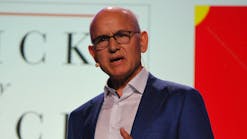Approach innovation like dating, not competition
It’s no secret that the advantages of a great business idea won’t last forever. But how do you course correct when your business starts to suffer? And what should you be doing to prevent your business from suffering by innovating proactively?
This was the theme of a presentation by David Robertson, senior lecturer at MIT’s Sloan School of Management, at Rockwell Automation’s Automation Fair 2024 event where he explained how to innovate “around the box” rather than “outside of the box” as many business consultants have long advised.
Reviving Lego
To help explain how this “around the box” innovation concept works, Robertson shared insights into the ups and downs experienced at Lego. He said that when the grandson of Lego’s founder took over the business in the late 1970s, he unleashed a wave of innovation that allowed customers to do more than build basic structures with Legos. This was the era marked by Lego’s introduction of minifigures and fantasy sets and is seen as “a golden period of innovation” at Lego that enabled the company to double in size every five years for 15 years.
But when these innovative ideas stopped working, Lego brought in a turnaround expert to help the company reconnect with the market. Amid the rise of PlayStation, Sega and Nintendo video games, changes in the company’s distribution channels with the rise of big box retailers, and the expiration of Lego’s patents, Lego became convinced they were being disrupted by these changes. Robertson said this belief led to the catastrophic decision to “innovate outside of the box” and leading Lego away from its building-focused core.
Despite several product misfires resulting from the company’s response to these changes, Lego’s fortunes improved when it returned its focus on building with the Star Wars and Harry Potter Lego sets. Based on the success of these sets, Lego saw the power of epic stories and devised a new set of Lego blocks that could be used to create what became its Bionicle action figures. Along with these new building blocks, Lego created a story around the Bionicle figures, making it a collectible with different stories introduced each year.
Since then, the company has become more popular and profitable than ever. Much of that success stems from the company's innovative approach to business.
Date your customers
Robertson said one of the most important ways to think about innovation is as dating your customers rather than fighting your competitors. “It’s about learning about your customers and becoming a bigger part of their lives,” he said.
This process starts with where you are not going to innovate and developing a clear focus on the product or service you will innovate around. “Honor and respect your core business but think about what else can you do with it,” advised Robertson. “Figure out who your customer is and what they need from your product or service. And consider that, if you had to give away your core product for free, how could you generate revenue when your customers use your products and how could you get more involved with your customer communities where they gather online or in person.”
Chords, not individual notes
To do this, Robertson said to think about different types of innovation as playing different keys on the piano. “In most situations, companies tend to play the same key again and again,” he said. “After all, if you’ve been successful with a product, you're probably going to play that product key again in the future. We tend to organize ourselves around the last successful innovation rather than the next success.”
To get to the next success, however, you have to think about what your customers are trying to do with your products. For example, people don't want drills, they want holes. So, what is it that you are promising them that they can do with your product or service?
Thinking this way will help you become more aware of complementary innovations around your core product or service. Here, Robertson pointed to Apple as an example.
In 2000, Apple was near bankruptcy. Then, in 2001, Steve Jobs pointed out how everyone’s lives — via their pictures, videos, calendars, contacts and movies — were all going digital. So, Jobs made the promise that Apple could help you manage your digital life. And he did this with the introduction of the iPod, iTunes and Apple stores. These products were all about the customer relationship as well as engagement with the Apple sales channel and business model.
“If you look at the iTunes store, for example, Apple hit a lot of innovation keys. They developed server farms to support selling music, established relationships with record labels and created ways for users to recommend music,” said Robertson. “By doing this, Apple was playing chords not just individual keys on the piano. That’s why you have to see innovation as more than just a product or service, there’s also the message and customer engagement and the sales channel.”
Robertson also pointed out that artificial intelligence can now help ease the process of innovation. “AI is very good at generating ideas to solve specific problems,” he said.
To showcase this, he created a website (robinn.co/atbgpt) that leverages OpenAI’s ChatGPT to generate up to 150 innovation ideas around a product or service.
Robertson noted that ChatGPT will spit out idea after idea, many of which you’ve probably thought about before — and some of the ideas won’t be very realistic. “But there's always a couple of nuggets that are interesting that might be combined with something you're already doing” and could spur a truly innovative idea.
About the Author
David Greenfield
Automation World
David Greenfield joined Automation World in June 2011. Bringing a wealth of industry knowledge and media experience to his position, David’s contributions can be found in AW’s print and online editions and custom projects. Earlier in his career, David was Editorial Director of Design News at UBM Electronics, and prior to joining UBM, he was Editorial Director of Control Engineering at Reed Business Information, where he also worked on Manufacturing Business Technology as Publisher.

